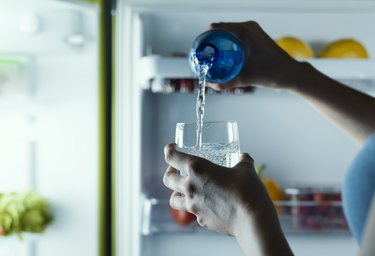
Weaning off of caffeine can be unpleasant. Before you go ahead and give up your daily java, you're probably wondering what kind of coffee withdrawal timeline you can expect — when will you start to feel symptoms? When will they be at their worst? How long does caffeine withdrawal last?
Caffeine is the most commonly used drug in the world, and many people who use it become dependent on it, according to a September 2013 comprehensive review in the Journal of Caffeine Research.
Video of the Day
Video of the Day
It's true that caffeine can give your brain a dose of dopamine, a chemical that affects your motivations and emotions, making you feel more awake. But caffeine doesn't affect the brain to quite the extent that other stimulants like ecstasy and meth do, meaning you can't get addicted to the substance.
Instead, the Cleveland Clinic describes it as a tolerance — when your body comes to expect a certain amount of caffeine every day, it adjusts to functioning with that dosage, so you need to keep getting more and more to achieve the desired effects. When you cut back, your body starts to hurt, mostly in the form of a headache or nausea.
Here's what you should know before you say ciao to your morning cup of joe, including how long it takes to detox caffeine, along with how to ease withdrawal symptoms.
Your Caffeine Withdrawal Timeline
Caffeine dependency — while not a true addiction, per the Cleveland Clinic — can make it hard to quit. Indeed, trying to avoid withdrawal symptoms like headache and nausea is one of the most common reasons why people continue drinking caffeine.
To understand how long caffeine withdrawals last, first consider how your body metabolizes this drug. After you take it, you can feel the effects of caffeine (increased alertness, reduced tiredness) about 15 minutes later, per the Cleveland Clinic. Caffeine stays in your system for the next few hours, sometimes taking as long as 10 hours to fully clear from your bloodstream.
This is why withdrawal symptoms can set in as quickly as 12 hours after your last dose of caffeine — though it could take up to 24 hours for some people — and can reach a peak anywhere from 20 to 51 hours later.
How long it takes to detox from caffeine will vary from person to person, but it typically lasts two to nine days. In general, the more caffeine you regularly drink, the worse your caffeine withdrawal duration is likely to be.
According to the Cleveland Clinic, signs of caffeine withdrawal include:
- Headache
- Fatigue
- Difficulty focusing or concentrating
- Muscle pain
- Nausea
- Irritability
Just remember that caffeine withdrawal is unpleasant but not dangerous, and the symptoms will go away eventually.
How Much Caffeine Should You Take In?
To avoid overloading on caffeine, stick to the expert-recommended upper limit of 400 milligrams per day (that's about four cups of coffee), according to the Mayo Clinic.
If you're experiencing any of the following issues, you might be getting too much caffeine, per the U.S. National Library of Medicine (NLM): restlessness and shakiness, insomnia, headaches, rapid or abnormal heart rhythm, nausea, dehydration and anxiety.
How to Cope With Caffeine Withdrawal

Now that you know how long caffeine withdrawal lasts, the best way to reduce symptoms is to gradually cut back on the amount you're drinking, per the Cleveland Clinic. You might think that you want your caffeine withdrawal timeline to be as short as possible, but stretching it out longer will mean it is less severe.
Just make sure to talk to your doctor if you have anxiety, depression, heart disease or another condition before stopping caffeine cold turkey.
1. Note How Much Caffeine You're Drinking
Determine how much caffeine you eat and drink by recording your intake for several days in a notebook, per the Mayo Clinic. Include caffeine from drinks as well as less obvious sources, such as medications, chocolate and other foods.
Knowing how much you take in will help you create a plan to gradually cut back in order to minimize withdrawal symptoms.
2. Go Slow
Try replacing every other cup of coffee or tea with a cup of decaf, per the Mayo Clinic. Here's a guideline for how long to detox caffeine: Eliminate one caffeinated beverage per day for a few days before cutting out additional caffeine. After several days, eliminate a second drink or other source of caffeine.
It's important to bear in mind, however, that decaf doesn't mean free of caffeine. Decaf coffees and teas have less caffeine, but it hasn't been completely eliminated. Per the U.S. Food and Drug Administration, decaf coffee might have 2 to 15 milligrams of caffeine per 8-ounce cup, so if you're extremely sensitive to caffeine, you should aim to cut these beverages eventually too.
3. Stay Hydrated
Drink plenty of water, per the Cleveland Clinic, as becoming dehydrated could worsen your headache or other withdrawal symptoms. Other caffeine-free beverage options include:
- Herbal tea and coffee
- Fruit juice
- Hot apple cider
- Seltzer
How Much Water Should You Drink?
Use this equation to determine how much water you should drink every day:
Body weight (in pounds) ÷ 2 = minimum ounces of water you should drink per day.
4. Check for Other Sources of Caffeine
Some common painkillers contain caffeine, per the Mayo Clinic. If you take these regularly, check the ingredients on the bottle, and consider switching to caffeine-free pain relievers.
5. Prioritize Sleep
Allow yourself extra rest while cutting back on caffeine. This will help combat the fatigue associated with stopping the stimulant.
6. Try a Pain Reliever
If withdrawal symptoms like headaches are too much, taking a pain reliever may help, according to the Mayo Clinic. Just make sure to pick a product that doesn't contain caffeine.
Tip
Once your caffeine consumption is under control, ask your doctor how much you can reasonably add back into your diet. For instance, the NLM discourages caffeine for people who are pregnant or have sleep disorders, migraines, anxiety, ulcers, irregular heart rhythms or high blood pressure, as the stimulant could pose a risk to their health.
- U.S. National Library of Medicine: “Caffeine”
- Food and Drug Administration: “Spilling the Beans: How Much Caffeine Is Too Much”
- Mayo Clinic: "Caffeine: How Much is Too Much?"
- Journal of Caffeine Research: "Caffeine Use Disorder: A Comprehensive Review and Research Agenda"
- Cleveland Clinic: "Caffeine: How to Hack It and How to Quit It"
Was this article helpful?
150 Characters Max
0/150
Thank you for sharing!
Thank you for your feedback!